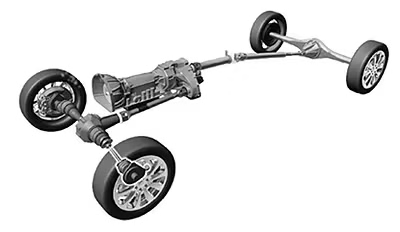What Is Suspension in a Car?
The suspension system ensures a vehicle can handle all kinds of road conditions. Read more about how it works here!
Key Points
There are many parts that contribute to a vehicle’s ability to get from place to place. The powertrain is a system made of several components that work to get energy transferred from the engine to the wheels to make a car move.
A quality powertrain is essential to help a vehicle reach proper acceleration. Keep reading to learn more about how the system works and the different roles each part of the system plays.
The powertrain in a car encompasses several parts that work together to push a vehicle forward by creating power from the engine, which is then sent to the wheels. The major powertrain components include:

Powertrain systems convert the engine’s power into motion. The condition of a powertrain dictates how efficiently this power transfer can occur.
A damaged or struggling powertrain system can negatively impact acceleration, handling and traction, making an uncomfortable and probably bumpy ride. If left unaddressed, powertrain issues could pose a safety risk.
On the contrary, a well-maintained, properly functioning vehicle powertrain improves the drivers’ experience. Acceleration is smooth, handling is easy and traction feels safe.
The term drivetrain is sometimes used interchangeably with powertrain; however, the drivetrain is just a way to describe all parts of the powertrain not related to the engine. This includes the drive shaft, transmission, differentials and axles.
Together, these mechanical components transfer power from the engine to the wheels, so they can rotate and maneuver efficiently at various speeds.
The drivetrain is the part of the powertrain system that encompasses the drive shaft, transmission, differentials and axles.
There are four drivetrain setups that are found on most vehicles: front-wheel drive (FWD), rear-wheel drive (RWD), all-wheel drive (AWD) and four-wheel drive (4WD).
In a front-wheel-drive vehicle, the engine runs horizontally and not vertically, which is known as transverse engine placement. This is where all the drivetrain components are located.
This setup allows power delivery to be sent to the front wheels since the motor’s weight is directly over them. This helps improve vehicle acceleration and traction control. A benefit of FWD is increased fuel efficiency.
With a rear-wheel-drive setup, engine power is sent from the transmission to the rear differential and then to the back two wheels of the vehicle. A standard RWD layout features an engine that’s longitudinally mounted at the front, with a driveshaft that goes through a tunnel built into the body of the vehicle.
RWD vehicles offer some of their own benefits, including less weight in the front of the vehicle and more precise handling, since the front wheels are not at risk of losing traction. This type of drivetrain is more commonly found in sports cars and luxury vehicles.
There are a few ways that an all-wheel drivetrain can be set up. One layout utilizes power being sent through the transmission into a center differential. The other layout is similar to a front-wheel-drive setup, with the engine connecting to the transmission in the same housing as the front differential and axles.
AWD vehicles offer increased traction since the power is going to all of the wheels, making it a great choice for very light off-road driving. However, they are the most versatile of the drivetrains and perform well on standard roads as well. They can operate without driver input, taking the decision for how to handle the road out of the driver’s hands, depending on the needs.
FWD vehicles are similar to AWD; however, they don’t send power to the center of the vehicle before it is sent to the front and rear axles. A four-wheel drive system is typically more durable and robust since it’s a system specifically designed with off-road driving in mind.
FWD and AWD drivetrains are great for providing traction and safety in poor road conditions. However, their handling on normal roads is not ideal compared with other drivetrain options.

It’s important to keep the parts of a powertrain in good condition. If wear and tear is building up on them, you might experience different symptoms. These can include:
And of course, if the check engine warning light comes on, this is an obvious sign to take your car to a trained technician who can help diagnose the problem.
To ensure powertrain longevity, regular preventative maintenance is key. This includes timely oil changes to keep the engine parts lubricated, routine transmission fluid checks to prevent gear wear, and drivetrain component inspection for signs of wear or damage.
Common issues with powertrain systems include transmission failure, which can manifest as difficulty shifting gears, unusual noises, engine misfires or reduced power output. Problems with the drivetrain can also lead to vibrations or a loss of efficiency in power delivery to the wheels. These issues often result from neglecting maintenance or natural wear and tear over time.
Yes, the vehicle powertrain can significantly affect fuel efficiency. A working powertrain optimizes fuel conversion to power and minimizes energy loss. A malfunctioning powertrain can lead to decreased fuel efficiency due to inefficiencies in acceleration.
With total auto technician employment expected to exceed 815,000 by 2033, it’s a great time to pursue a career in the industry.47 Employers are ready to hire those with the right education and experience to fill in-demand roles.
Students in the 51-week Automotive Technology program offered at Universal Technical Institute (UTI) have the opportunity to get hands-on training on all kinds of car systems, including powertrains, during our courses.1,7
Want to learn more? Click here to connect with an Admissions Representative and take the first step toward a future you’re excited about.
Universal Technical Institute of Illinois, Inc. is approved by the Division of Private Business and Vocational Schools of the Illinois Board of Higher Education.